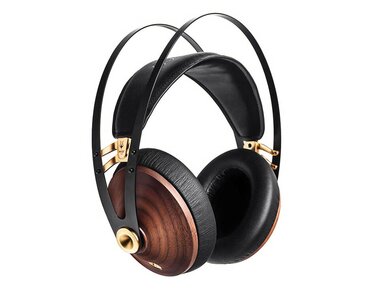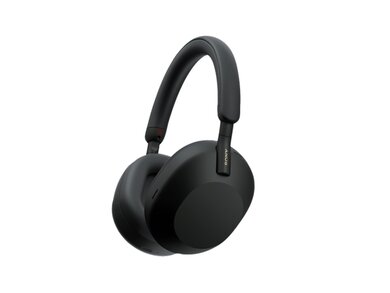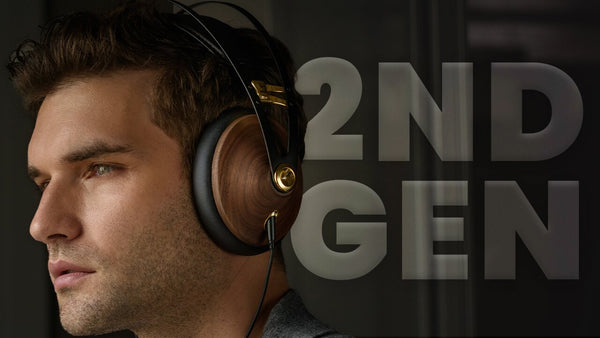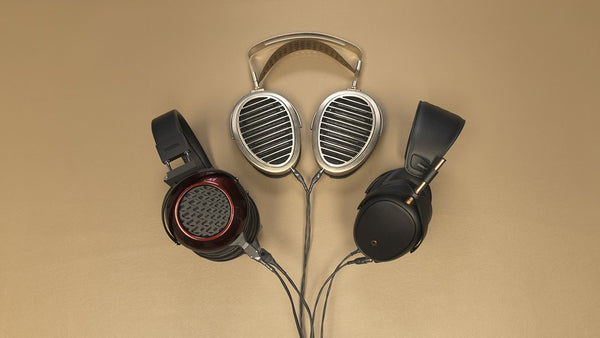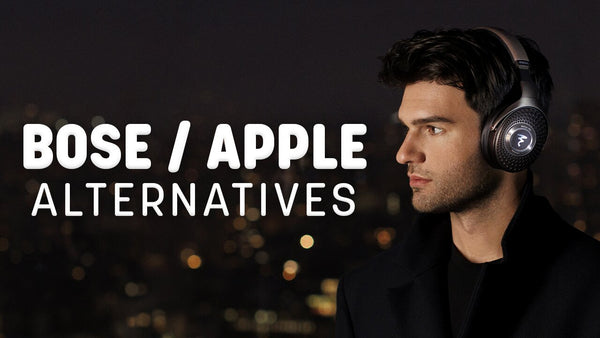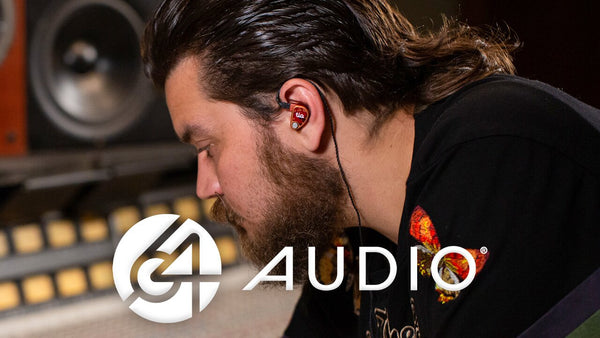The Future of Wireless Hi-Fi Headphones
Read Time: Approx. 8 min.

Is the Future of Wireless Hi-Fi Headphones as Close as we think?
Wireless headphones are on the brink of reaching equal footing with wired headphones—But they're not quite there yet. A couple of things have to happen first, and we think Apple has played a pivotal role in proving that these advancements are not only around the corner, but potentially already here.
Before we can understand exactly what needs to happen for us to finally reach the endgame for wireless HiFi headphones, we have to understand the technology behind the current generation of wireless headphones.
The Future of Wireless Headphone Technology
Bluetooth vs. Wireless or Wi-Fi Connection
When it comes to setting up wireless audio, there are two primary ways: Wireless RF and Bluetooth connection. Most wireless headphones use Bluetooth technology for connectivity rather than Wireless RF. Bluetooth connection is a cost-effective way to do short-range communication to send a digital signal stream from a source to a wireless headphone. Bluetooth compresses the audio signal, deteriorating the playback sound quality of music files. A true wireless connection or hopefully in the future Wi-Fi connection is going to yield higher quality performance and better sound quality, but most wireless headphones just aren't built to support Wi-Fi connection yet.
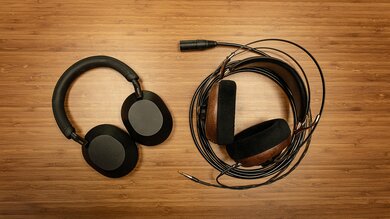
Ultimately, wireless is only as good as the wireless technology in the headphones. A manufacturer can produce a pair of wired and wireless headphones for the same price, but it's how the money is spent that matters.
Let's compare a $300 wired pair of headphones to a $300 pair of wireless headphones. In the wired pair, for example, the 99 Classics from Meze Audio, the manufacturers only had to pay for the driver inside the headphones. Whereas, in a wireless pair, there's the cost of the driver, amplifier, DSP, Bluetooth technology, and built-in DAC circuit.
A pair of wireless headphones utilize digital signal processing correction (DSP for short) to improve the digital-to-analog conversion and overall sound quality. In some cases, it's the band-aid to solve deficiencies in a product. DSP is a way to make a less expensive driver sound better by applying correction and EQ to it.
So, for the same price, the driver in the wired pair can sound better because the manufacturer can spend more on a higher-quality driver. The money is spread a bit farther in a wireless headphone, so corners may be cut and a less expensive driver can be added knowing that DSP can over-correct the lower quality.
For example, the Focal Bathys is a premier wireless headphone priced at $699, and the newer generation Bathys MG at $1,499 is even better. What you're paying for in these wireless headphones is the quality of the driver. Focal prioritized making a high-quality driver and then turned their attention to the features that make the headphones wireless. The Sony WH-1000XM5 wireless headphones are priced at $398. Active noise cancellation (ANC) technology makes them some of the best noise-canceling headphones on the market, but the Bathys trumps them in driver quality.
Current Bluetooth Shortcomings
To understand why a Wireless RF or Wi-Fi Connection will be the endgame for wireless headphone technology, we must first discuss the disadvantages of Bluetooth — Starting with its bandwidth limitations.
Bandwidth Limitations
Wireless headphones seem like the Swiss army knife of high-end HiFi headphones. Not only are you ditching the cord, but you're eliminating the need for additional equipment and accessories like DACs and amplifiers... because they're built right in. Yup, wireless headphones are equipped with their own built-in DAC circuit, headphone amplifier, and battery.
But like anything that seems too good to be true, it's because it probably is. Everything is crammed inside of a pair of wireless headphones, even the signal. The Bluetooth signal is compressed and doesn't sound as good as a normal, conventional wired headphone, because you're using the digital-to-analog converter, amplifier, etc. that's inside the wireless headphones. The quality of these components may be lower to effectively fit them inside a wireless headphone, without having to weigh a ton or cost a fortune.
Bluetooth has a lower bandwidth than Wi-Fi, which affects the signal Bit rate and resolution. A Wi-Fi signal has a much larger bandwidth for the signal so you can do hi-res audio transfers without any degradation or loss in sound quality.
Limited Range

Bluetooth connections are meant for short distances, typically up to 30 feet. Because signals can be blocked by physical barriers like walls, furniture, and other obstacles, the limited range of Bluetooth doesn't bode well for Bluetooth devices that need to be connected over longer distances. The audio quality will deteriorate when transmitting through obstacles. So, even though you can step away from the source device, you can only go as far as the range will allow before the headphones lose connection.
Bluetooth Compatibility
Bluetooth's compatibility is dependent on the versions and codecs of the wireless headphones and source device. Bluetooth codecs determine how the signal is transmitted from the source device to the audio output. Bluetooth versions define the capabilities of the Bluetooth hardware and firmware. Current Bluetooth Audio codecs include aptx, LDAC, SBC, and LHDC.
For instance, Bluetooth version 5 has a better range and a more consistent Bluetooth connection than Bluetooth 4.0. It's worth noting that devices with different Bluetooth versions can still connect with each other. The drawback to this though, is that even if the wireless headphone has Bluetooth 5 but the source device, let's say a smartphone like the iPhone or Android has Bluetooth 4.0, the headphones will default to using Bluetooth 4.0 - which is lower than what they can support, resulting in the headphone's operating at a lower performance.
What Needs to Happen: The Road to Wi-Fi
While Bluetooth codecs have greatly improved over the years and continue to get better, we think the next step in the evolution is to utilize a Wi-Fi connection over Bluetooth. Wi-Fi opens up many possibilities for how the device can now be used. High-resolution wireless headphones can become as close to the sound quality as wired headphones in this case.
Improved Battery Technology
Thanks to its large bandwidth, Wi-Fi can support hi-res audio transfers, but with that comes the need for more powerful batteries and larger circuits. By going to Wi-Fi and high-resolution audio files, let's say 24bit 96k or even better 192k, the power consumption requirements are too much for the small rechargeable batteries we are utilizing now. Now, how does one fit that into an already-packed pair of wireless headphones?
Well, you don't want to make the headphones extremely heavy and cumbersome, but you don't want to have a battery life that'll drain out in an hour's time. You want something that's going to last for a ten-hour airplane flight and not fatigue your ears because it weighs too much. The technology for batteries must be made smaller, but still have the same charge as the old-sized batteries to properly support the more powerful Wi-Fi solution. Luckily, batteries are evolving and becoming much smaller and much more efficient with every passing day.

Component Design Necessities and Improvements
Why don't we have Wi-Fi now? Several reasons. Cost, circuit size, and power requirements. Until we can get Wi-Fi circuits and all the workings around them smaller and more power efficient, there's just not enough space, especially in in-ear monitors (IEMs) to make this a reality.
There are some great examples of wireless headphones that use more robust DAC circuits, like the Focal Bathys.
The road to Wi-Fi isn't paved yet, but there's been some gravel laid. Audio Technica has made strides in wireless technology. The ATH-WB2022 is a wooden wireless headphone that houses the world's first completely balanced audio output system — Independent Bluetooth circuits, DACs, amplifiers, and batteries for the left and right ear cups. The headphones support up to 24-bit/96kHz high-resolution sound sources with both wireless and USB-C digital connections.
But this comes at a cost. These headphones are priced at $2700. Are they as good as a pair of $2700 wired headphones in terms of sound quality? Maybe not, but they are probably the best-sounding wireless headphones on the market. You're paying for the wireless technology. It's an expensive endeavor at the moment to push the envelope of wireless headphones.
Although this model is a limited edition in honor of Audio Technica's 60th anniversary, it's a glimpse into the ever-evolving future of wireless technology.
Now that we know where wireless headphones are, and where they need to go, what is a concrete indication that this tech is even possible in the short term? This is where Apple unexpectedly enters the chat.
The endgame for wireless headphones boils down to shrinking tech that currently takes up too much power and space. Apple's new M series silicon chips have truly shaken up the entire tech industry in this respect. Their power output, size, and efficiency are simply unmatched at a consumer level. The implication of what this means for wireless headphones can be made more clear by the recently announced Apple Vision Pro.
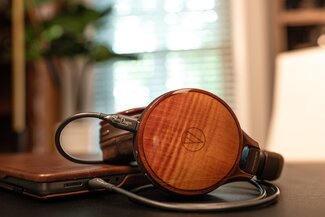
Taking a look at all of the components that are packed into the Apple Vision Pro is quite a journey. There is essentially an entire MacBook Pro with an astonishing amount of tech in every square centimeter. All of this tech is compacted to fit into a pair of goggles that grant a similar amount of space that a pair of headphones might have — But with way more tech than a pair of Bluetooth headphones would ever need.
This seems to be an indicator that if Apple were to devote true attention to the wireless HiFi headphone market with their current tech right now, they could make the first truly endgame pair of wireless headphones. Will they do that? Almost certainly not. But if Apple could do it now — Somebody else will do it very soon.
The Vision Pros are controversially priced at $3500, but, for that price, you are getting essentially an entire pro workstation, even if the first-generation software will be limiting. The Audio Technica WB2022s currently sit at $2700. For that price you are getting a pair of headphones with some pretty neat wireless audio tech, but obviously none of the augmented reality tech of the Vision Pros. The WB2022s are a fantastic pair of headphones that's worth the investment if you want the top-of-the-line wireless headphones right now. What these prices indicate to us, however, is that we may see somebody manufacture a pair of wireless headphones that approach the endgame very, very soon.
That's something to get excited about.
Featured Products
Related Videos
Wired vs. Wireless Headphones: How to Choose
Why You Should Buy These $2.7k Wireless Headphones
Top 5 Wireless Headphones of 2022

